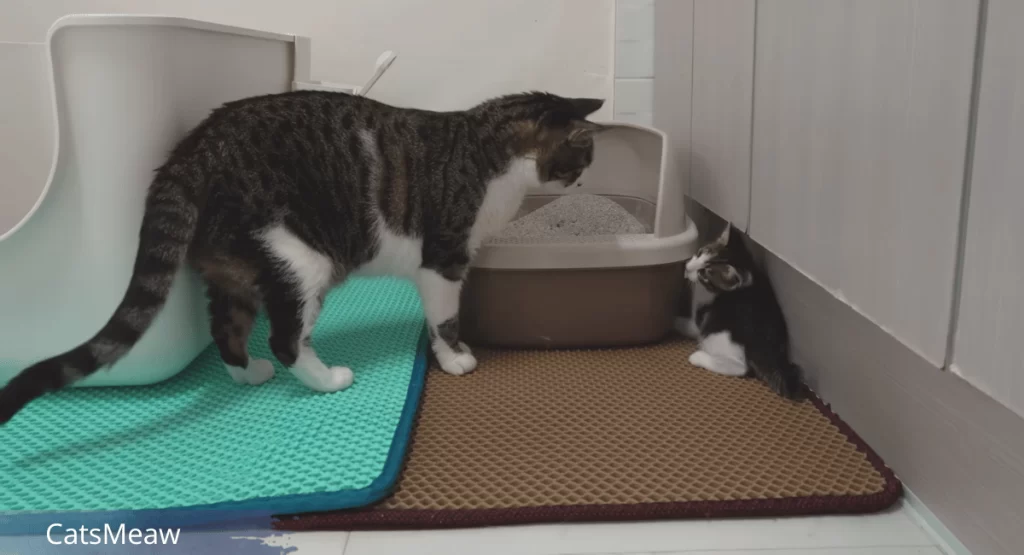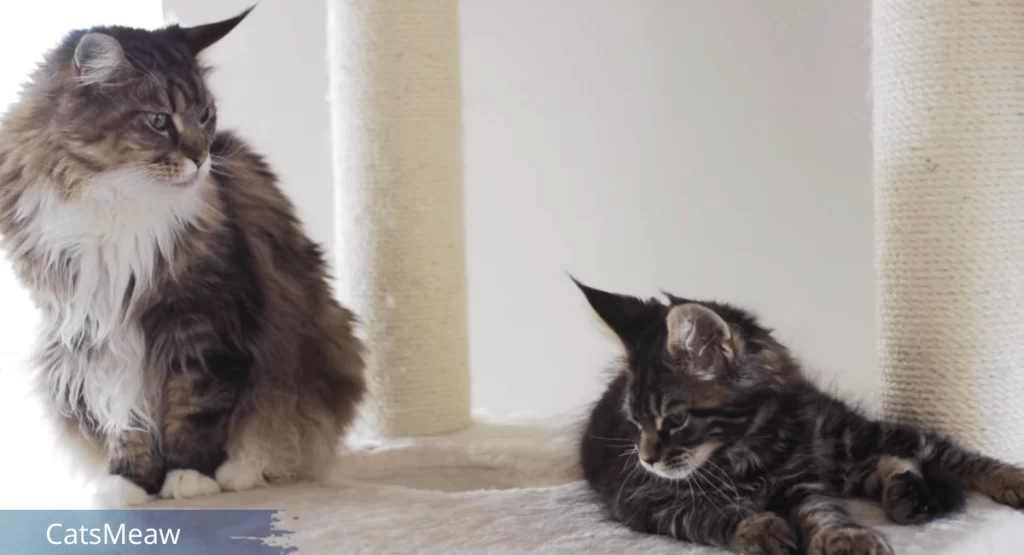Bringing a new kitten into your home can be a joyous occasion filled with excitement and anticipation. However, if you’re already the proud owner of an older cat, you might find yourself facing a unique set of challenges. The process of introducing a kitten to an older cat requires patience, understanding, and a careful approach to ensure a smooth transition for both your new and existing pets.
It’s not just about opening your home to a new family member; it’s about creating a harmonious environment where both your kitten and older cat can thrive. In this guide, you’ll discover invaluable insights into making this critical period a success, ensuring both your feline companions can coexist peacefully and form a bond that will enrich your home life for years to come.

Understanding the dynamics between kittens and older cats is crucial in facilitating a positive introduction and cohabitation. Kittens are naturally playful, curious, and have boundless energy, traits that can sometimes overwhelm or irritate an older cat who’s set in their ways and less inclined to engage in frequent play. Recognizing and respecting these differences is the first step towards creating a balanced household where both cats can feel happy and secure.
Table of Contents
Understanding the Dynamics Between Kittens and Older Cats
Before introducing a new kitten into your household, it’s important to understand the dynamics that can arise between an older cat and a kitten. Older cats are generally more sedate and set in their routines, and they may not appreciate the high energy levels and playful nature of a kitten. This discrepancy in behavior and activity levels can lead to tension if not managed correctly.
Kittens, with their insatiable curiosity and playful demeanor, can inadvertently encroach on the older cat’s territory and personal space, leading to potential conflicts. It’s also worth noting that older cats may have health issues that make them less tolerant of a boisterous kitten. Therefore, understanding and planning for these dynamics is crucial in creating a peaceful coexistence between your cats.
By taking the time to observe and understand the unique personalities and needs of your older cat, you can tailor the introduction process to suit both animals. This understanding will enable you to anticipate potential problems and take proactive steps to mitigate them, ensuring a smoother integration of your new kitten into the family.
Preparing Your Home for a New Kitten
Preparing your home for the arrival of a new kitten is an essential step in the introduction process. This preparation involves more than just purchasing toys and setting up a litter box; it requires thoughtful consideration of how to make your home a comfortable and safe space for both your new kitten and your older cat. Start by designating separate areas for each cat, ensuring they both have their own space to retreat to when they need solitude. This separation can help prevent territorial disputes and give your older cat time to adjust to the presence of the new kitten without feeling overwhelmed.
Invest in additional resources such as food bowls, water dishes, and litter boxes. Having multiple resources can prevent competition and reduce stress between your cats. It’s also wise to create vertical spaces or safe spots where your older cat can observe the kitten from a distance, helping them to acclimate to each other’s presence gradually.
Introduce the scent of the kitten to your older cat before the actual meeting. This can be done by swapping bedding or gently rubbing a cloth on one cat and then the other. Familiarizing them with each other’s scent helps reduce the initial shock and aggression when they finally meet face to face.
Introducing a Kitten to an Older Cat
The first introduction is a momentous occasion and should be approached with caution and patience. Choose a neutral space for the introduction, where neither cat feels ownership over the territory. This neutrality can reduce territorial aggression and give both cats an equal footing. Initially, keep the kitten in a carrier during the introduction, allowing the older cat to approach and investigate at their own pace. It’s crucial to monitor their reactions closely and be prepared to intervene if signs of aggression or distress emerge.
Related: New Kitten Checklist: Best Essentials for your Feline
During these initial meetings, keep the interactions short and sweet. Gradual exposure can help build familiarity without overwhelming either cat. Positive reinforcement plays a key role in this stage; rewarding both cats for calm and non-aggressive behavior can encourage acceptance and tolerance.

Remember, patience is key. The introduction process can take weeks or even months, depending on the personalities of your pets. It’s important to move at a pace that’s comfortable for both your older cat and your new kitten, allowing them to dictate the pace of their budding relationship.
Managing the Initial Interactions Between the Kitten and Older Cat
The initial interactions between your kitten and older cat are critical in setting the tone for their future relationship. It’s essential to supervise these early encounters closely, looking out for signs of aggression or fear. If either cat appears distressed, calmly separate them and try again later. It’s better to err on the side of caution during these early stages to prevent negative associations from forming.
Creating positive associations can greatly aid in smoothing the paths of their relationship. Engage in joint play sessions that encourage gentle interaction, or feed them simultaneously while keeping a safe distance between the two. These shared positive experiences can help build a bond between your kitten and older cat, teaching them to associate each other’s presence with enjoyable activities.
Intervention should be gentle but firm. If you notice any aggressive behavior, distract the aggressor with a toy or treat rather than punishment, which could exacerbate the tension. Through consistent supervision and intervention when necessary, you can help guide their relationship towards a more peaceful and friendly direction.
Providing Separate Spaces and Resources for the Kitten and Older Cat
Ensuring that your kitten and older cat have their own separate spaces and resources is crucial for their cohabitation. This separation not only reduces competition and potential conflict over resources but also gives each cat their own safe haven. Each cat should have its own litter box, food and water bowls, and sleeping area. This segregation helps to prevent territorial disputes and allows each cat to have a space where they feel secure and unthreatened.
In addition to physical resources, consider the importance of personal space. Cats are territorial by nature, and having a designated area that they can claim as their own is vital for their mental well-being. Encourage the use of these separate spaces by placing treats and toys in each area, making them appealing places for your cats to spend time in.
Over time, you may find that your cats begin to share spaces and resources voluntarily. However, it’s important to let this happen at their own pace. Forcing shared resources too soon can lead to setbacks in their relationship. Patience and respect for their individual needs are key to a harmonious coexistence.
Gradually Increasing Supervised Interactions
As your kitten and older cat become more comfortable with each other’s presence, you can begin to gradually increase their supervised interactions. Start with short periods of time in the same room, always under close supervision. Look for signs of relaxation and curiosity, which are positive indicators that they are becoming more accepting of each other.
Related: Best Interactive Toys for Indoor Cats
Interactive toys can be a great way to encourage mutual play without direct contact, allowing them to engage in a shared activity that fosters positive associations. As their comfort level grows, you can gradually increase the duration of their interactions, always ready to intervene if necessary.
The goal is to slowly build up to unsupervised interactions, but this should only be attempted once you are confident in their ability to coexist peacefully. This confidence comes from observing consistent positive interactions over time, without signs of aggression or distress from either cat.
Conclusion and Final Thoughts
Introducing a kitten to an older cat is a process that requires patience, understanding, and a careful approach. By preparing your home, managing their initial interactions thoughtfully, and providing separate spaces and resources, you can create a conducive environment for a harmonious relationship between your pets. Remember, each cat is an individual, and the pace at which they become comfortable with each other will vary.
Embrace the journey with patience and positivity, and you will be rewarded with the joy of seeing your cats develop a bond that adds to the warmth of your home. The effort you put into this process reflects your love and commitment to their well-being, ensuring that your feline family members can enjoy each other’s company in peace and happiness.
Bringing a new kitten into your home doesn’t have to be a stressful experience. With these tips and a thoughtful approach, getting a kitten with an older cat can be a smooth and rewarding endeavor, enriching your life with the joys of feline companionship.
Given the constraints of this format, this piece serves as an introduction to the thoughtful and comprehensive care required when introducing a kitten to an older cat. For more in-depth guidance, continued research and consultation with a veterinary professional are recommended.
